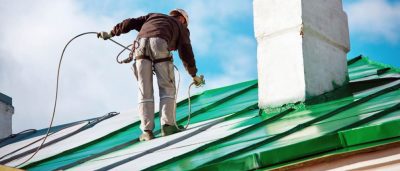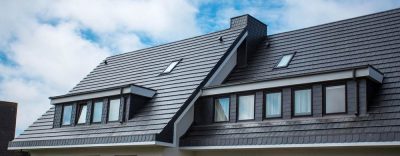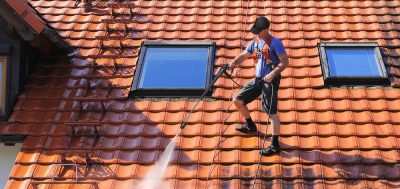- Oneflare /
- Cost Guides /
- Roofing

How much does a Roof cost?
$45 - $90 per hour
How Much Does a Roof Cost?
Homeowners can expect a minimum of $50 to $55 per square metre for roofing materials such as concrete, metal, and asphalt shingles. Clay, copper, timber and slate drive the cost up, requiring from $100 to $300 per square metre. Thus, the cost of roofing a typical house starts around $12,000 for less expensive materials and $30,000 for more costly materials.
The following is the average labour cost for a roofing job in different states around Australia:
| State | Average Cost for Roofing Labour |
| NSW | $415 |
| VIC | $400 |
| WA | $250 |
| SA | $400 |
| QLD | $310 |
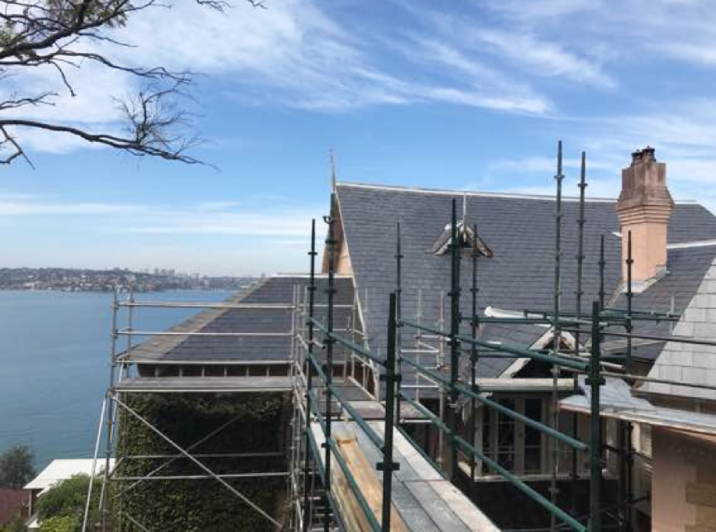
Newly built roof. | Source: C & N Roofing Pty Ltd and maintenance
Factors Impacting the Cost of Roofing
Roofing types and costs vary greatly, which means the range of price points is more extensive than ever. Of course, size and labour costs will impact the final cost of a new roof. Other issues that can drive up your costs include roof design, pitch, access, and environmental issues. The most significant factor that can nearly double your roof replacement cost is asbestos removal.
Roofing material
Conventional roofing products today include concrete shingles and asphalt shingles. These human-made products are generally the least expensive. Corrugated metal roofing prices are budget-friendly, but copper will cost you much more. Clay looks good and is more affordable than the cost of a new tile roof. If it fits with your home’s design, an updated version of an old timber roof is a fun choice. On the other hand, you can decide to opt for a modern waterproof membrane roof system.
When working with other materials like Laserlite roofing, it’s essential to know how to cut Laserlite roofing properly. Cutting Laserlite requires specific techniques and tools to ensure a clean and accurate cut, which can affect the overall quality and appearance of the finished roof.
Size of the roof
When looking for a quote, your builder will most likely ask what the size of your roof is in square metres. As you would expect, a more extensive roof means more materials and therefore, higher labour costs.
Pitch or angle of your roof
A steep roof may be more expensive due to the labour involved. If it is very steep, it may require more preparation and specialised safety equipment. The slope of your roof can result in a more elaborate design. Factors such as a 5-degree roof pitch per metre, calculating roof load width, and understanding the minimum roof pitch for corrugated iron or the minimum fall for a roof are essential considerations when planning your roofing project. By taking into account the roof load width and other specifications, you can ensure your roof is structurally sound.
Design of the roof
Roofing supply prices may be more if your roof design is complicated. You should ask your contractor if there are any special requests about your roof design that may be driving up the cost. You may be able to have a lower bill if you aren’t trying to replicate an intricate design.
Labour costs
You may not know the exact labour costs unless you ask your contractor. Having a final quote is more indicative of how much work it may entail versus finding out what the hourly labour rates are.
Difficult site access
If your home is hard to get to or you have an inaccessible roof, this can will increase your roofing costs. Steep roofs to access increase costs as there is a higher safety risk to your builder.
Asbestos cement roof
Asbestos removal is highly depending on the condition, amount, location and accessibility of the asbestos. If asbestos is in your roofing materials, you can expect it to drive up the cost of a new roof. A licensed removal company must remove the asbestos affected area. Prices of asbestos removal can start from $250 to remove in the eaves of your roof and up to $5,500 for removal in an entire roof. Double-check if removal of asbestos in your roof eaves is part of in the original quote.
Environmental
There are energy-smart roofing materials that may help reduce your cooling bills. Furthermore, in scorching climates, your roof may need to be made of suitable materials to withstand the heat. There is an imitation slate tile, for instance, that has been known to fail within ten years due to Australia’s harsh sunlight. Solar tile roofs are a newer invention that works similarly to solar panels and provides your home with energy.
Maintenance requirements
Generally, your roofing process should include hauling away the old tiles, but you should make sure these services are within the official quote before signing. To maintain the roof, you’ll want to check the roof every two to five years. The edges are most likely to deteriorate first.
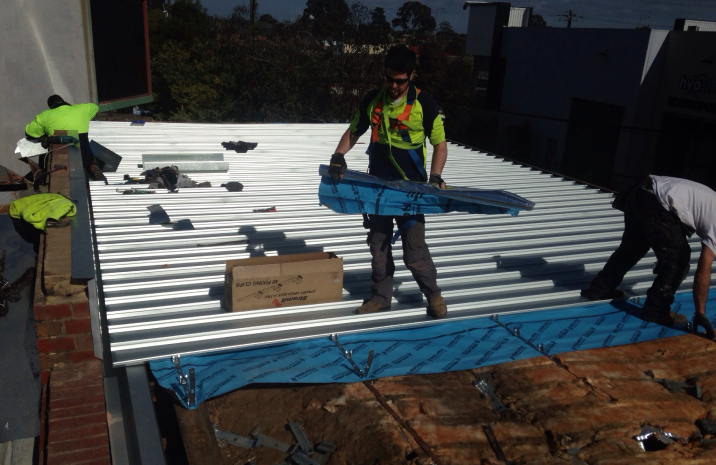
Metal roof being built. | Source: Advanced Quality Roofing
Estimates for Different Types of Roofing Costs
New roof
A new roof made from materials costing between $50 and $105 per square metre, will cost you from $12,000 to $30,000. An expensive product, such as copper, wood shingle, timber or tile can vary from $160 to $280 per square metre. Your total bill for a new roof with these materials can equate to approximately $30,000 to $60,000.
Materials
The least expensive materials are metal and steel. Despite copper and quarried tiles costing more, these are materials that care expected to last 50 years instead of the 15 years resulting in a long-term return on investment. Real wood shingles are another roofing material that can also raise the value of the home at resale.
| Roofing Materials | Average Price Per Square Metre |
| Metal and steel roof | $55 |
| Concrete shingles | $50 |
| Asphalt roof shingles | $55 |
| Copper roof | $190 |
| Slate roof | $260 |
Installation
The least expensive materials are also the easiest to install. Naturally, tile and clay, starting at $105 per square metre and timber from $160 require a slower, more careful installation regimen. The intricate roof laying process increases labour costs.
Gutter Installation
Gutter and downpipe installation can lay hand-in-hand with installing a new room, with gutter labour costs around $60 per hour. A Oneflare customer who needed a replacement gutter with a 7-metre downpipe received a quote of $400.
Chimney Removal
The cost to remove chimney from a roof is a demolition and repair job that will add to the overall expense of a new roof. However, it may be worth it if the chimney is decaying and contributing to frequent leaks.
Roof ventilation
Roof ventilation installation cost varies and recommended in today’s homes. A solar fan or attic fan installation is a good investment, especially if you are already redoing your roof and wanting to make more use of your attic.
Does the Cost Differ Based on Location?
The cost of a new roof or other roofing needs are more dependent on the size, materials and complexity of your roof compared to the location of your home. Other factors that can change the cost is the accessibility to your property and transportation costs of materials or machinery needed.
Tips on How to Create an Accurate Estimate
Tip #1: To get the best price and the best product, you should get multiple quotes for roofing. Information you need to supply is the size of your roof and the type of roofing material you want.
Tip #2: Make sure your quotes are itemised to protect yourself from surprises. Be sure to ask about warranties, and for the roofing supplies, you need to buy. Ask your roofing specialist if clean-up and hauling are included in the quote, as this can save you a lot of time.
How to Hire a Roof Specialist
Before you hire a roofer, make sure they have the right licenses to do the job. They should have considerable experience and find if they have licences for roof tiling, slating or cladding.
Insurance
You’ll need to ask if they have insurance for accidental damage or worker and onsite injuries. Whether your contractor has insurance or not can separate a worthy professional to an inexperienced builder.
Written quote
Ask for an itemised written quote starting with stripping off and hauling away the old roof to the end clean-up process. Material costs and labour costs should be specified. If there are conditions which may drive up the price, your builder should inform you upfront.
Warranty on materials
Your material warranty could be void if the installation of the roofing materials doesn’t meet standards. Make sure your roof specialist has experience with the specific style and product you want. Many have relationships with the roofing manufacturer and can show you a certificate that demonstrates their expertise with that particular material.
References
Ask for references from other homeowners who have used the same roofer. Your roof is essential to your home’s integrity, and you want to be sure this roof can last a minimum of 15 years.
Tips on How to Save Money When Hiring a Roof Specialist
Tip #1: Remember to think about long-term goals when hiring a roofer. You don’t want the cheapest bid if the quality of the labour or materials is low.
Tip #2: Many homeowners get guttering and downpipe installation simultaneously to reduces the costs because there is some overlap in labour.
* The cost data is based on Oneflare and third-party sources
Real Oneflare Customer Quotes
Peter's Roofing Job
Job type
Roof repair
Problem
Leaking from ceiling
Damage from
Heavy rain
$500inc. gst
Quoted by Kelly's Roof Repairs and complete home maintenance
Dave's Roofing Job
Job type
Roof repairs
Problem
Leaking from ceiling
Roof type
Colorbond
$200inc. gst
Quoted by Roof Youth
Agatha's Roofing Job
Job type
Repairs
Problem
Leaking from skylights
Other jobs
Repointing roof
$2500inc. gst
Quoted by Bulletroofing
